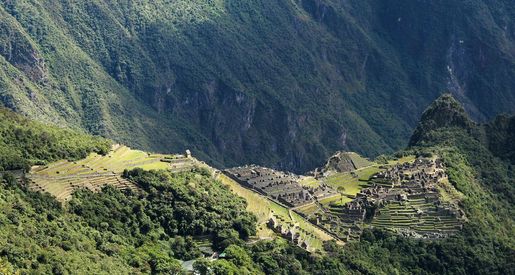- Details
- Category: Knowledge Centre
the beginner's guide to the machu picchu hike
Welcome to the beginner's guide to the Machu Picchu hike! If you've ever dreamed of heading off on an epic adventure through the heart of the Andes Mountains, then this is for you. We'll walk you through everything you need to know to tackle this iconic trek!
What is Machu Picchu?
The Machu Picchu hike is one of the most awesome adventures in the world, not just in Latin America. This incredible wonder is an ancient Inca citadel stands at 2,430m above sea level. It's shrouded in mystery and surrounded by awesome natural beauty. Built in the 15th century and later abandoned, it remained hidden from the outside world until its rediscovery in 1911 by American explorer Hiram Bingham. Today, it stands as one of the most iconic and sought-after travel destinations in the world, attracting thousands of visitors each year.
Is the Machu Picchu Hike for Beginners?
Absolutely! Despite its reputation as a challenging trek, the Machu Picchu hike is accessible to hikers of all levels, including beginners. With the right preparation and mindset, anyone can conquer these legendary trails and experience the awe-inspiring wonders of the Inca civilization. Keep reading for our training recommendations!
Which Route Should You Choose to Machu Picchu?
We offer two distinct routes to Machu Picchu: the renowned classic Inca Trail, a truly special journey, and the more remote Tomacaya route, which we introduced in 2020 as a fresh alternative. If you fancy something a little quieter with less crowds, try out our Tomacaya route. Looking for the classic Inca Trail, following ancient steps laid by the ancient Incas? Well try the Inca Trail!
Both routes are a journey of discovery and excitement as you traverse ancient Incan ruins, mystical cloud forests, and breathtaking mountain valleys, culminating in the awe-inspiring citadel of Machu Picchu.
What’s the difference between the Inca Trail and Tomacaya Route?
- Unbelievably beautiful with the best views in the region to feast your eyes upon including views of Mt Salkantay (6270m)
- 700 meters higher than any other route to Machu Picchu (totalling 4900m)
- Remote region coming across far less people than any other area
- A tougher challenge than the classic routes, perfect for our hardcore EverTrekkers
- No other company offers this route meaning you get an exclusive experience that still brings the challenge!
- Steeped in history, soaking up the feeling of walking the same footsteps as the Inca did over 500 years ago
- A full historic immersion; you'll wind your way through historic sites with no shortage of Inca ruins to explore
- Meeting other trekkers & villagers is guaranteed and you'll be buzzing from the social energy on this ancient route
- We include an extra day acclimatization compared to most itineraries
- Although still a great challenge, it's a slightly easier trail compared to our Tomacaya route making this the perfect choice for your first high altitude trek
This journey is a monumental check off your bucket list and a timeless trekking experience no matter which route you take.
essential things to know before hiking machu picchu
When is the best time to hike to Machu Picchu?
The best time to hike the Inca trail and the Tomacaya route is between May and October when the weather is dry and the trail is less crowded. Permits for the Inca Trail are slightly less hard to obtain by us at this time due to lower numbers. Permits for the Tomacaya are easier overall to acquire due to its lesser known nature.
The Festival of the Sun (Inti Raymi) typically occurs towards the end of June, drawing in crowds to Cusco as people make their way to Machu Picchu. Another peak period for hikers is Peru's national holiday at the end of July, with many choosing to tackle the Inca Trail or visit Machu Picchu via train. If going during this month, choose the Tomacaya over the Inca Trail to avoid crowds on the trail, but it could be busy once you arrive at the highlight of the trip! The dry weather remains decent for tourists throughout August and carries on into September, making it a popular time to visit.
As November arrives, the rainy season kicks off, although trekking conditions can still be ok and the crowds are a little less compared to the summer months.
December brings wet weather and an influx of tourists due to the holiday time, resulting in busy accommodation and flight costs despite the less-than-ideal weather conditions. But January sees a decrease in crowds, although it remains wet, making it a quieter period to visit without the holiday rush.
What permits do I need for Machu Picchu?
Before setting out on your journey, EverTrek will sort out the relevant trekking permits. The Peruvian government requires all trekkers to be accompanied by a licensed guide service or tour operator with the appropriate permits, so don’t panic! We have you sorted!
The only thing we ask from you is once booked, send us your passport info as soon as possible! We will need this as early as possible to secure the relevant permits.
With the Inca trail permits especially, It’s never too soon to send us your passport info once you have booked your trek. We need this information for obtaining them in good time and are needed as early as possible! The Machu Picchu site is a busy one and we don’t want anyone missing out on their once in a lifetime adventure - once the permits are gone, they’re gone!
How do I Book my Flights to Machu Picchu?
Get those flights booked! Booking the wrong flight can be an expensive mistake and knowing what to do when you land can be scary, so we’ve decided to help by answering some of the most asked questions.
What Airport should I be flying to?
International flights are not included in your booking so you will need to arrange your return flight to Peru. You need to book a flight to Jorge Chavéz International Airport in Lima.
What day should I aim to arrive?
You should arrange to arrive at Lima on day 1 of your itinerary. As it generally takes longer than a day to arrive in Lima, you should book your flight to leave the UK the day before.
Where do I go once I’ve arrived in Lima?
Before you arrive in Lima, we will have made a reservation for you at the Wyndham Costa del Sol Lima Airport hotel. This is a short walk from the arrival terminal and is where you will spend the night before heading to Cusco on day 2 of your itinerary. Don’t worry you won’t have to do all of this alone, a member of the local EverTrek team will be there to help.
Is my flight to Cusco included?
Yes! We will arrange your return flight to Cusco and back again to Lima and be with you to make the process super easy.
What happens if I arrive early in Lima?
If you decide to arrive early in Lima, you are free to arrange your own time. All you must do is arrive back at the Wyndham Costa del Sol, (Lima Airport Hotel) on day 1 of your itinerary, recommended check in time is from 15:00.
Your room will have been booked by us so you can check in and relax for the evening, you will then need to be ready & in the lobby the next morning (usually between 08:00/08:30 on Day 2) to meet up with your group & Guide, who will escort you back to the airport to board your flight to Cusco.
What happens if I want to extend my trip and depart later than the final day?
If you wish to extend your stay in Cusco please let us know at least 90 days in advance as we will need to pre-book your return flight back to Lima. If you plan on staying longer in Lima this is no problem and we will book your flights as per the normal itinerary, once you land you are free to explore at your leisure.
What is the food & accommodation like on the Machu Picchu hike?
On both our Machu Picchu routes, Tomacaya and Inca, you'll enjoy a combination of hotels and tents throughout the trip.
Your first nights accommodation will be in the 4 Star Wyndham Costa del Sol hotel conveniently located directly outside Lima Airport.
On the Trek itself you’ll be camping in tents which will be all ready and waiting for you at the end of a hard day hiking which believe me is an absolute delight!
The food on the trek can only be described as AMAZING! How the team managed to cook on a camping stove in a tent and produce such fantastic meals is totally beyond us.
Below is a sample of the type of tasty treats you can expect:
Breakfast Sample Menu: Coca tea and a range of herbal teas, hot chocolate, quinoa drink, fruit and yogurt, granola, omelet, toast and jam, juice.
Lunch Sample Menu: Grilled vegetables, potato and sweet potato dishes, white corn, fried rice, meat or fish.
Dinner Sample Menu: Guacamole and fresh nachos, quinoa & other soups like minestrone & vegetable, grilled meat, pasta, rice dishes, Andean pan chuta (traditional baked bread), pan fried fish. All evening meals included a starter, soup course and range of main dishes!
How fit do I need to be for the Machu Picchu hike?
While the Machu Picchu hike is accessible to beginners, it's essential to be in good physical condition before embarking on the trek. Our best advice is to put a weighted bag on your back when training, about five kg (weights or water) in your backpack (or 10 kgs if you are feeling extra adventurous), and just go for it and do some miles. If you've just bought some flashy new hiking boots, wear them in as much as you can! You don’t want to be uncomfortable when you are on your adventure. The physical challenge is part of what makes this experience so special.
Get on that step master or just ascend some stairs if you have them, you’ll need the leg strength, especially for the Inca trail which has a crazy amount of steps!
What is the altitude like on Machu Picchu?
The high altitude of the Andes Mountains can present challenges for some trekkers, so it's essential to acclimatize properly before beginning the hike and during. In our itineraries we include days for acclimatizing so don't panic! Plus you can always spend a few days in Cusco before setting out to allow your body to adjust to the altitude.
The highest point of the Inca Trail is Warmiwañusca (aka 'Dead Woman’s Pass'.) which stands at an altitude of 4,198m (13,769 ft). The highest point of the Tomacaya Route is the impressive Tocto pass, at 4900m. Machu Picchu itself stands at 7,972 feet (2,430m) above sea level. So safe to say on either route, you'll tackle some high points!
Something you can do to test your body at altitude is to head over to the Altitude Centre in London, they have everything you need to test your fitness and to see how the body reacts at altitude.
Grab your free consultation with them via your members area when you book your trek.
Top tips - Stay hydrated! Drink plenty of water. Listen to your body, listen to your guide, be honest with them about your health, and you’ll smash it!
What vaccinations do I need for Machu Picchu?
Make sure you're up to date with your vaccinations before heading off on the Machu Picchu trek. These include familiar jabs like typhoid, tetanus, and diphtheria, which are recommended every 10 years. Additionally, consider optional vaccinations such as hep B and rabies, especially if you travel regularly to regions where these diseases are present.
Remember, if you book with us then you benefit from discounted vaccinations with Nomad - find more info here.
what kit do i need for the machu picchu hike?
Clothing and Gear
- Hiking boots: You will need a good pair of hiking boots which are well worn in and comfortable. The EvertTrek Yeti’s are fond of the brands Meindl, Scarpa, La Sportiva, Salamon and Salewa.
- Waterproof jacket and trousers: Be prepared for rain showers by packing lightweight waterproof outerwear. A lightweight Gore-Tex or similar jacket is essential.
- Base layers: Moisture-wicking base layers will keep you comfortable and dry during long days on the trail.
- Mid Layer / Outer Layer: The morning and evenings on the Peru Treks can be cold so packing a lightweight fleece or mid layer and down jacket is a smart way to keep yourself warm without add
- Sun hat and sunglasses: Protect yourself from the sun's rays with a wide-brimmed hat and UV-blocking sunglasses.
Essentials
- Day Pack : You’ll need a hiking backpack to carry your daily essentials, 25l to 30l combined with a hydration bladder. We recommend the Osprey Talon 33L if you prefer a specific women’s fit pack, we like the Lowe Alpine Airzone Trail or Osprey Tempest.
- Duffel bag for trek (7kg weight limit)
- Sleeping bag/mat: To reduce your packing sleeping bags and mats can be hired, an option we’d highly recommend!
- Water bladder 2lt - 3ltr or bottle: Stay hydrated on the trail by carrying plenty of water with you.
- Sunscreen: Don't forget to protect your skin from the sun's harmful rays with a high SPF sunscreen.
- Sun hat and sunglasses: That pesky sun!
- Mosquito Repellent - although the route we trek has a very low risk of malaria, mosquito bites are definitely not something you want to pick up as a souvenir! A good quality mosquito repellent with a high deet content is definitely something you’ll be glad you packed.
- Beanie Hat: For the morning and evenings when the temperature drops.
- Neck Buff: Very versatile item, great for keeping your neck, head and face warm out away from the sun and dust.
- Headlamp: For moving around camp at night and finding things in your tent when the sun goes down.
- Gloves x 2: A lightweight liner pair of gloves and a thicker insulated pair of gloves.
- Trekking Poles: These are great and very helpful for the steep trails, making the climbs easier and taking a lot of the pressure off your knees on the descents. It's worth noting to bring rubber ends to your poles for when you enter the Inca Trail section of the trek.
- First aid kit: Be prepared for minor injuries and ailments with a compact first aid kit containing essential supplies.
- Wet wipes: For a cheeky tent wash.
- Small trekking towel – For a cheeky tent dry.
- Snacks - we always recommend bringing something that will give you a boost when you are flagging, be it Haribo, energy gels or protein bars - whatever will help get you through! We escpecially love CLIF Bar for a proper boost of energy!
For a more comprehensive list, just get in touch at 02920 003216 or email This email address is being protected from spambots. You need JavaScript enabled to view it. for more recommendations.
What can I do after the Machu Picchu hike?
Rainbow Mountain - This is an amazing natural wonder at an altitude of 5200m so if you are like us Yetis, it offers the perfect blend of altitude, scenery and adventure!
Want to read more about this incredible extension? View the full itinerary here!
Lake Titicaca - This is the largest lake in South America and the highest navigable lake in the world, Lake Titicaca sits at an altitude of 3,812m and offers an experience like no other.
Want to read more about this incredible extension? View the full itinerary here!
To add one of these awesome experiences onto the end of your trek, just give us a call at 02920 003216.
Which route will you choose?
The Machu Picchu hike is a once-in-a-lifetime adventure that promises to be both challenging and rewarding, but which route will you choose?
The quieter and lesser known Tomacaya Route. Or the classic Inca Trail?
With good preparation, mindset and humor, anyone can complete this famous trek and take in the magic of Machu Picchu, not matter which route you take.
Hit the buttons below to find out more about your next adventure.
Previous Articles
- How to Train for the Everest Base Camp Trek
- How high is Everest Base Camp?
- How much spending money do you need for the Everest Base Camp trek
- What's the accommodation like on an Everest Base Camp trek
- Are showers available on the Everest Base Camp trek?
- What type of toilets are available on an Everest Base Camp Trek






